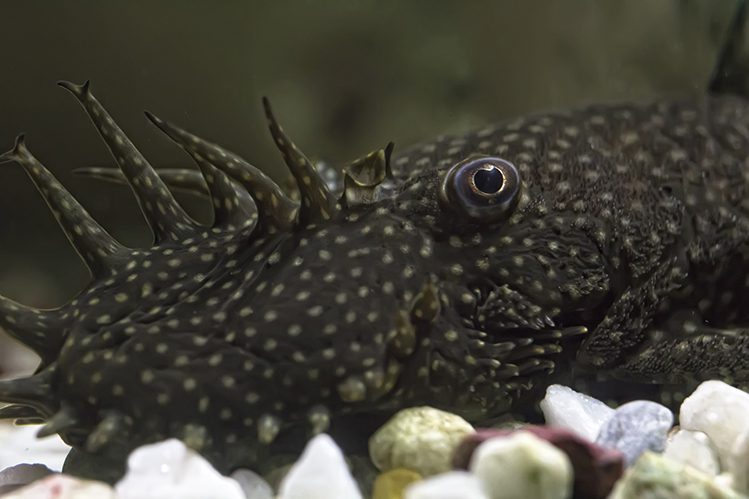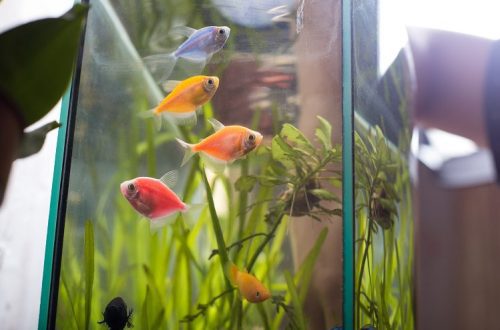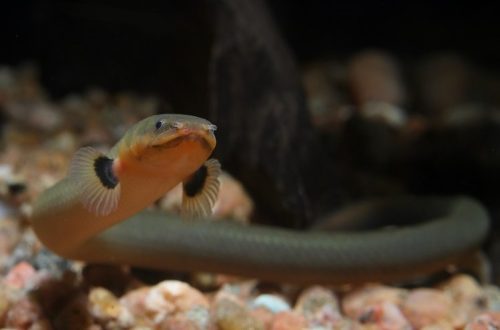
Varieties of catfish: agamix, stellate ancistrus, brocade pterygoplicht, otocinclus and others
Catfish are unusual aquarium inhabitants. Amusing habits and the desire to clean up the aquarium made catfish favorite aquarists. We have collected for you tips on caring for these fish and interesting information about the most curious varieties of catfish.
The choice of catfish for a home aquarium does not begin with a trip to the pet store, but with a search for information about the species that interest you. Immediately consider whether you can provide the necessary conditions of detention throughout the life of the pet. Some types of catfish can live in an aquarium with good care for up to 15 years.
All catfish lack scales. Typically, larger catfish have bare skin, while smaller ones have plates to protect them from potential enemies. Catfish’s bizarre whiskers are sensory organs that help fish find food. Whiskers can be a pair of barely visible processes, or they can be three pairs of large locators.
You need to purchase small catfish in the company of an experienced expert or from responsible breeders and sellers. Some species are capable of turning from tiny fry into giants, requiring a separate living space of 300 liters. The fact that you made a mistake with the view will become clear when the overgrown catfish announces a hunt for the smaller inhabitants of the aquahouse.
If you are new to catfish care, it is best to heed the advice of aquarium experts and first get an unpretentious and not very large common ancistrus. Take a closer look at the behavior of the catfish, see what kind of food he likes best. These observations will serve you well in the future. With ancistrus, we will begin the story about interesting types of catfish.
Adult Ancistrus vulgaris can grow up to 15 centimeters in length. Ancistrus belong to the family of chain catfish. Males are distinguished by very prominent antennae-growths. Recognizable brown color with light spots. Ancistrus need good filtration in an aquarium. Provide aeration, be mindful of water changes. Maintain a temperature of 20-28 degrees, without sudden fluctuations. The acidity of the water should be between 6 and 7,5. Hardness – within 20.
Ancistrus vulgaris behaves peacefully with other fish. But in an aquarium with several ancistrus, one of the catfish will certainly take a leadership position. To avoid conflicts in a container with a volume of less than 80 liters, it is better to keep only one ancistrus. Neighborhood with scaleless fish, as well as sluggish fish with veil fins, is undesirable; out of curiosity, catfish can feel their fins with a sucker mouth. This rule applies to most catfish, except for the very tiny and harmless ones. But the neighborhood with large aggressive fish is already dangerous for the catfish themselves. In general, goldfish and territorial cichlids will not work.
Star antsistrus even more beautiful than usual. The color is dark brown or dark chocolate with bright white dots distributed evenly over the surface of the body. You can say catfish with peas. The young stellate ancistrus boasts a spectacular white edging of the dorsal and caudal fins. In catfish older than a year, the white edging gradually disappears.

Star Ancistrus lives in the rivers of South America, Brazil. But it also feels great in the aquarium. Males grow up to 20 centimeters in length and grow a lush mustache. The females are smaller, their antennae are smaller, and the muzzle is more round. A funny detail: in the fry of Ancistrus stellate, white dots that have not yet had time to be distributed over the body form a smiley face on the back.
Brocade pterigoplicht – a close relative of Ancistrus. Only much larger. An adult can be over 50 centimeters in length. Decided to get a pair of brocade catfish pterygoplichts? First, think about where to put the 400 liter aquarium. This is especially important in light of the fact that they show intraspecific aggression.
The catfish has an amazing color – the body of the pterygoplicht is covered with large brown spots, separated by light yellow veins. A sort of leopard color in the underwater world. The special pride of the catfish is an impressive dorsal fin with 12-13 rays. There is a small ridge in front of the base of the fin. The eyes are small, the nostrils stand out noticeably. The body of the miracle fish is covered with bone plates, with the exception of the abdomen.

Pterygoplichts prefer water temperatures around 23-27 degrees, acidity at 6,5-7,5, hardness up to 15. With good care, they are ready to delight you with their presence in the aquarium for more than 15 years. In nature, they like slow-flowing rivers and flooded lands during the rainy season. In an aquarium, the brocade pterygoplicht needs a good filtration system, aeration, driftwood.
Fans of smaller fish are attracted by varieties of armored catfish corridors. Representatives of the family in length from three to 12 centimeters. Corridors need a whole company of their own kind, start a flock of five or six catfish at once. Water temperature – 20-25 degrees, acidity – 6-7,4, hardness – 1-17. Proper care will allow the fish to live up to ten years.
Among the corridors, a special love of aquarists won speckled catfish. Corridors are valued for their iron health, they do not overreact to environmental factors. They get along well with ancistrus in the same aquarium. You can also dilute the company of corridors with barbs, zebrafish, guppies and other calm fish.
Somik agamix – an amusing representative of the armored catfish family. Secretive, does not like to be seen, prefers subdued lighting. It grows up to 10-12 centimeters in length, lives up to 10 years. Friendly to the point of impossibility, will not get along only with large cichlids.
We can say that catfish agamix outwardly resembles a mysterious creature from a science fiction film. But we still try to describe it more accurately. Its large body is elongated, the head is similar in shape to a triangle, and has three pairs of whiskers. The triangular shape is also read in the dorsal fin. The adipose fin and pelvic fins are small. Noteworthy is the pectoral fin with a thickened serrated first ray. This miracle of the underwater world cannot be caught from the aquarium with a net, the catfish runs the risk of getting entangled in it with sharp fins.
And what about color? The body of the catfish and fins are brown, with an ornament of round yellow spots, on the caudal fin the color spots turn into two rows of transverse stripes. The mustache is decorated with alternating white and dark stripes. Impressive!
Even more amazing is that these catfish can sing. Catfish makes unusual sounds, reminiscent of crackling. With catfish agamix you will definitely not get bored! Likes water with a temperature of 25-30 degrees. Hardness – up to 25, acidity – in the range from 6 to 7,5.
Otocyclus – real fans of cleanliness in the aquarium. These chain catfish are best settled in a flock of at least three individuals. Catfish otocinclus constantly eats algae, carefully, but very carefully cleans the plants. Representatives of the largest variety of otocinclus reach five and a half centimeters in length. They live up to six years. They are very peaceful, they can be hooked, for example, zebrafish, viviparous guppies.

Otocinclus have a charming appearance. A characteristic feature of all otocincluss is a stripe on the side. The stripe can be gray or black, solid or intermittent. The front of the tail is decorated with a color spot.
They are very sensitive to changes in water parameters, they should be transplanted to another aquarium with caution. They are suitable for water temperatures of 22-25 degrees. Acidity – 5-7,5, and hardness – 2-15. They eat algae all the time. From specialized feeds for otocincluss, it is better to choose feeds with algae in the composition.
If otocinclus often swallow air from the surface, aeration in the aquarium is insufficient. These catfish adore clean water, they will gladly settle in a dense herbalist.
Some recommendations apply to the maintenance of almost any type of catfish. Catfish prefer to have shelters in the aquarium – nooks and crannies where no one will disturb them. You can buy beautiful decorations or driftwood at the pet store. Snag is not just a decoration, it is a source of cellulose for mustachioed underwater inhabitants. Grottoes, hollow coconut, clay shards can serve as shelters. Do not overdo it with plants in aquariums. Catfish like to spend time at the bottom, for this a significant part of the soil should be an open space without vegetation. Take seriously the choice of soil for these bottom fish. Sand or fine, rounded soil is best, which will not harm the sensitive skin of catfish. They scour the bottom in search of goodies. Or even burrow into the sand.
Choosing the right diet for catfish is quite simple, but it is better to seek the advice of a specialist. Choose a food designed specifically for your fish species. Please note that chain catfish food is not suitable for armored catfish. The mustachioed inhabitants of the underwater world need both plant and protein foods. To make it convenient for catfish to eat, give preference to food that sinks, rummage in the ground in search of something to eat – this is their element. The main thing is to remove the remnants of the meal from the aquarium in a timely manner. Treat catfish with a vegetable treat once a week. It can be circles of zucchini or cucumber, scalded with boiling water.
We wish your catfish to live long and delight you with their amusing behavior and bright appearance!





